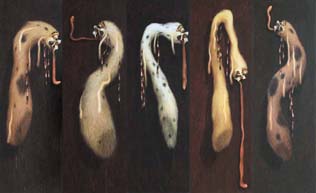Nostalgia Exhibition: Ubud, Bali
 Two Balinese artists look home with Nostalgia through the easels of a craft they mastered in Yogyakarta. Leaving has changed them, and they know they can never return to the Bali of their youth. That place remains only in their memory.
Two Balinese artists look home with Nostalgia through the easels of a craft they mastered in Yogyakarta. Leaving has changed them, and they know they can never return to the Bali of their youth. That place remains only in their memory.
Tongues of Desire greet the visitor upon entering the grounds of Komaneka from Ubud’s Monkey Forest Road. Fiery gold and red tongues protrude from fanged faces on wire-frame torsos, where constructs of powerful masculine bodies are haphazardly draped with objects of lust.
I Wayan Sudarna Putra’s depiction of the male body as lust is contrasted by his idea of Inner Beauty, a mass of flowing hair regally taken over by that same tongue of desire.
What is the matter, with desire? Freud tried to bring this out of the shadows through his discussions on the ego. While in Europe desire tends to be a private affair, in Bali, desire, as a source of power and vitality, be it positive or negative, is celebrated through rituals, mythology and art.
It is experienced as a communal phenomenon in public performances and is absorbed into the psyche by each individual in their own way.
The installations, sculptures and paintings at Nostalgia, an exhibition at Komaneka Fine Art Gallery, are an exploration and comment on contemporary Balinese desires, an apt continuation of this longstanding tradition.
Such as seen in trance performances, when the kris jagged dagger thrust upon the chest cannot pierce the skin. This spectacle celebrates the power of Rangda, and to Balinese with Buddhist leanings, it is also a reminder to curb desire, whose very nature is indestructible.
Neither good nor evil can ever fully vanquish the other. This polarity exists as an eternal battle within each and every one of us: the only hope and goal being the achievement of balance.
Using this rich imagery, Sudarna Putra comments on desires growing rampant in his community as well as his personal battles controlling his desire for independence.
After the May 2006 Yogyakarta earthquake, his family begged him to return to the safety of Ubud. Moving his studio into his family compound for the first time, this young artist came into contact once again with the communal way of living in each other’s pockets.
Traditional images, so pervasive in Ubud, became all the more vivid in his mind’s eye that this painter of silhouettes, nudes and toys chose to use his fine brush-strokes to express desire through the physical aspects of Rangda’s tongue.
“I was astonished to see the desires of the people around me completely taking over their thought patterns,” he explains, “in matters of inheritance, for instance, there are many who demand things they have no right to.”
“It is as if Durga is dancing freely today in Bali,” he comments, alluding to another spiritual aspect of Rangda as a manifestation of Durga, the Goddess of Destruction.
Desire, whether it is in matters sexual, greed or inheritance, tends to be kept under covers in the West. Bali deals with these issues in group therapy, openly talking about their rogue elements.
Through the lens of memory, I Made Arya Palguna, still living in Yogyakarta, paints a modern Bali. Provoked by long-distance phone calls, he uses his personal style to depict communal phenomena such as backstabbing, substance abuse, myths and ideals.
In Backstabbing, Palguna expresses a sentiment that often haunts him: an astonishment that the Balinese are exchanging blows, fighting over material possessions. Then they maintain animosity.
“Because I live away, I can have this view of the Balinese as a single family,” explains Arya Palguna, adding “through this painting I am yelling out to the people in my village to stop quarreling.”
Quarrels aside, home is still where his heart is.
“I always think that the air of Ubud is cleaner and fresher than any other place,” he admits, “This is the memory I cherish.”
In one of his paintings, smokestacks and a blazing white horizon lead to a barren landscape with skeletons of withering trees. A family enjoys a picnic in the foreground. Home, where the family grows, is eternally green and lush.
The aesthetic realities of Arya Palguna and Sudarna Putra have been made possible because they have developed enough distance to see all the sides of their home.
Where Sudarna Putra struggles to reconcile his ambivalence with the flood of traditional imagery bombarding him upon his reluctant return to Bali, Arya Palguna continues to find relative freedom from Yogyakarta to reassess his roots.
Both artists continue to be slaves to the communal social construct that are their perceived identities as they dance through emotions of guilt, longing, fondness and aversion to their past selves.
Like most intellectuals and artists, their efforts to forge bold new identities cannot help but fluctuate between the desire to dissociate and belong to a rapidly changing social landscape. But why, oh why is it that one must leave home to grow?
Nostalgia
through June 12
Komaneka Fine Art Gallery
Jl. Monkey Forest
Ubud, Gianyar 80571
Bali
tel: (0361) 97 60 90
fax: (0361) 97 71 40
e-mail: gallery@komaneka.com
website: https://gallery.komaneka.com
Kadek K. Adidharma